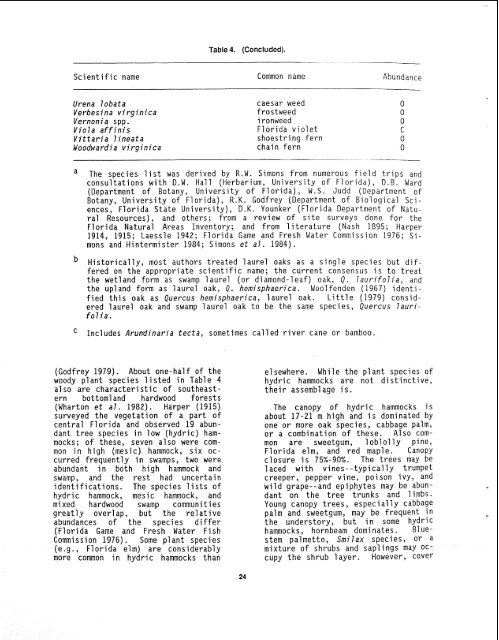The Ecology of Hydric Hammocks - USGS National Wetlands ...
The Ecology of Hydric Hammocks - USGS National Wetlands ...
The Ecology of Hydric Hammocks - USGS National Wetlands ...
You also want an ePaper? Increase the reach of your titles
YUMPU automatically turns print PDFs into web optimized ePapers that Google loves.
Table 4. (Concluded).Scientific name Common name AbundanceUrena lobataVerbesina virginicaVernonia spp.Viola affinisVittaria lineataWoodwardia virginicacaesar weedfrostweedironweedFlorida violetshoestring fernchain ferna <strong>The</strong> species list was derived by R.W. Simons from numerous field trips andconsultations with D.W. Hall (Herbarium, University <strong>of</strong> Florida), D.B. Ward(Department <strong>of</strong> Botany, University <strong>of</strong> Florida) , W. S. Judd (Department <strong>of</strong>Botany, University <strong>of</strong> F1 orida) , R.K. Godfrey (Department <strong>of</strong> Bi 01 ogi cal Sci -ences, Florida State University), D.K. Younker (Florida Department <strong>of</strong> NaturalResources), and others; from a review <strong>of</strong> site surveys done for theFlorida Natural Areas Inventory; and from literature (Nash 1895; Harper1914, 1915; Laessle 1942; Florida Game and Fresh Water Commission 1976; Simonsand Hintermister 1984; Simons et al. 1984).Historically, most authors treated laurel oaks as a single species but differedon the appropriate scientific name; the current consensus is to treatthe wetland form as swamp laurel (or diamond-leaf) oak, Q. laurifolia, andthe upland form as laurel oak, Q. hemisphaerica. Wool fenden (1967) identifiedthis oak as Quercus hemisphaerica, laurel oak. Little (1979) consideredlaurel oak and swamp laurel oak to be the same species, Quercus 7aurifolia.Includes Arundinaria tecta, sometimes called river cane or bamboo.(Godfrey 1979). About one-ha1 f <strong>of</strong> thewoody plant species listed in Table 4a1 so are characteristic <strong>of</strong> southeasternbottomland hardwood forests(Wharton et a7. 1982). Harper (1915)surveyed the vegetation <strong>of</strong> a part <strong>of</strong>central Florida and observed 19 abundanttree species in low (hydric) hammocks;<strong>of</strong> these, seven also were commonin high (mesic) hammock, six occurredfrequently in swamps, two wereabundant in both high hammock andswamp, and the rest had uncertainidentifications. <strong>The</strong> species 1 ists <strong>of</strong>hydric hammock, mesic hammock, andmi xed hardwood swamp communitiesgreatly over1 ap, but the relativeabundances <strong>of</strong> the species differ(Florida Game and Fresh Water FishCommission 1976). Some pl ant species(e.g., Florida elm) are considerablymore common in hydric hammocks thanelsewhere. While the plant species <strong>of</strong>hydric hammocks are not distinctive,their assemblage is.<strong>The</strong> canopy <strong>of</strong> hydric hammocks isabout 17-21 m high and is dominated byone or more oak species, cabbage palm,or a combination <strong>of</strong> these. Also commonare sweetgum, loblolly pine,Florida elm, and red maple. Canopyclosure is 75%-90%. <strong>The</strong> trees may be1 aced with vines--typically trumpetcreeper, pepper vine, poison ivy, andwild grape--and epiphytes may be abun-dant on the tree trunks and limbs.Young canopy trees, especi a1 ly cabbagepalm and sweetgum, may be frequent inthe understory, but in some hydrichammocks, hornbeam dominates. Bluestempalmetto, Smilax species, or amixture <strong>of</strong> shrubs and sap1 ings may occupythe shrub layer. However, cover

















